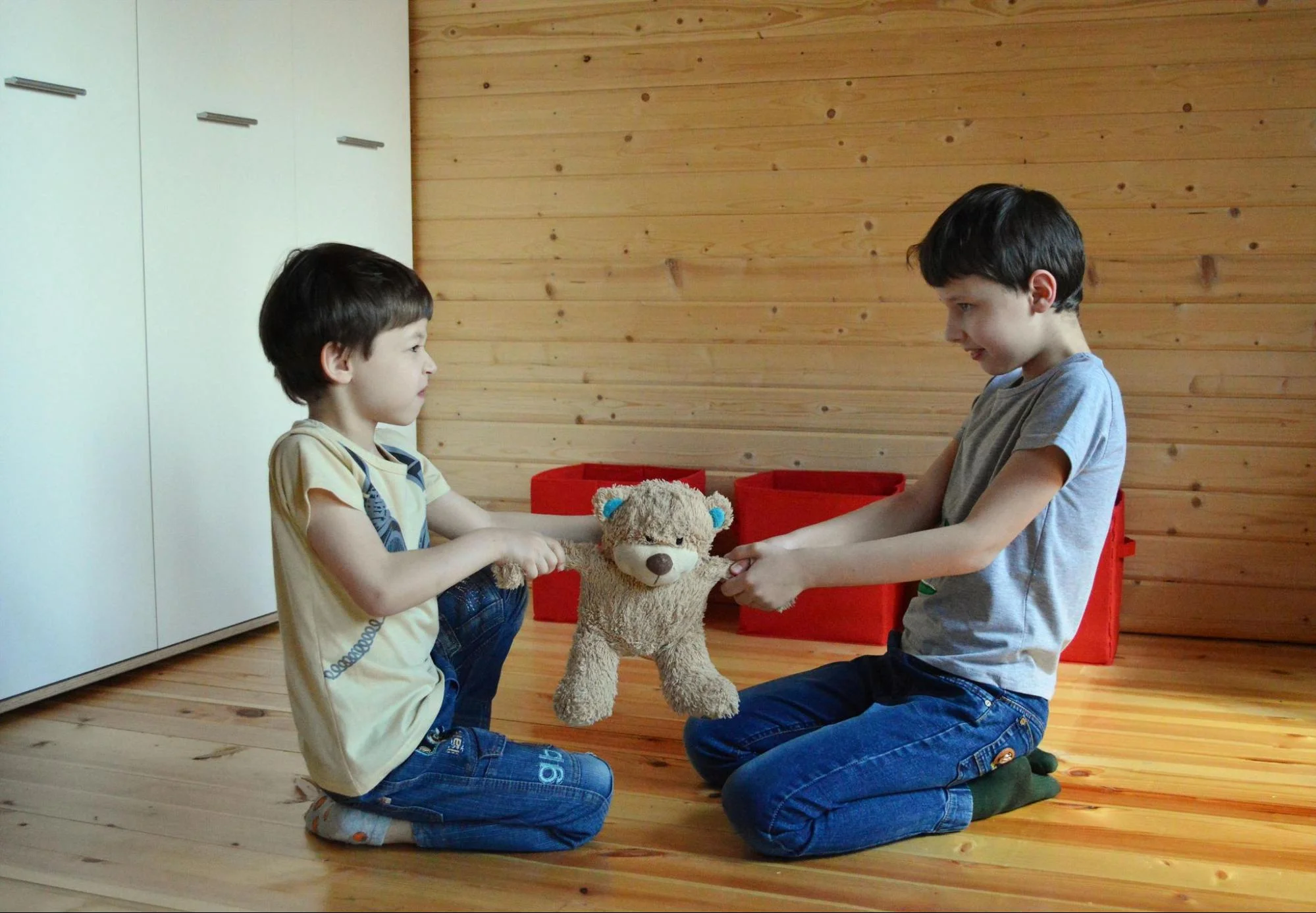
Ah, the familiar sounds of sibling warfare: the bickering, the wrestling matches over the TV remote, and the endless debates over whose turn it is to walk the dog. It’s a never-ending saga that leaves parents feeling like they’re stuck in a perpetual game of referee.
You find yourself wondering if they’ll ever stop, if peace will ever reign in your household again. But amidst the chaos, there’s a glimmer of hope and humor.
After all, what’s childhood without a little rivalry? As siblings compete eagerly for supremacy over the last cookie or the comfiest spot on the couch, they’re also learning valuable lessons about negotiation, compromise, and the art of a well-timed eye roll.
So, while the battles may rage on, take heart in the fact that beneath the squabbles lies a bond that’s stronger than any stuffed animal or slice of pizza.
What is sibling rivalry?

Sibling rivalry refers to the competition, jealousy, and conflict that often occur between brothers and sisters. It is a natural and common phenomenon in many families where siblings compete for attention, resources, and status within the family dynamic. Sibling rivalry can occur in various ways, such as arguing, fighting, teasing, or competing for parental approval and affection. It typically begins in early childhood and may continue into adolescence and adulthood, although its intensity and form may change over time.
Recommended Reading: 5 WAYS TO TEACH YOUR KIDS ABOUT SAVING MONEY [AND SPEND LESS]
Findings of Research on Sibling Rivalry
| Year | Research Findings |
|---|---|
| 2014 | Research findings state that being bullied by a sibling doubled the risk of depression and self-harm in early adulthood. |
| 2021 | Study on family dynamics links sibling bullying to a lower sense of competence, life satisfaction, and self-esteem in young adults. |
Researchers state sibling relationships are often the longest-lasting relationships in individuals’ lives: Cicirelli, 1995; Hernandez, 1997; U.S. Bureau of the Census, 2005.
While sibling rivalry can be a source of tension and conflict within the family, it also serves important developmental functions. It provides opportunities for children to learn important social and emotional skills, such as conflict resolution, negotiation, and empathy. Through navigating the challenges of sibling rivalry, children can develop resilience and learn to navigate interpersonal relationships in other areas of their lives.
Ultimately, sibling rivalry is a normal and inevitable aspect of family life, but with understanding, patience, and effective communication, parents can help their children navigate these dynamics and foster positive sibling relationships.
Understanding and Nurturing Sibling Relationships

Having siblings is like making music, some high notes, some low notes, but it is always a beautiful song.
1. The impact of birth order on sibling dynamics
Whether a child is the oldest, middle, youngest, or only child can significantly influence sibling dynamics. For example, the oldest children may take on leadership roles and feel a sense of responsibility, while the youngest children may seek attention or rebel against authority. Middle children may feel overlooked or strive to differentiate themselves. By acknowledging and validating each child’s feelings and needs, parents can promote empathy, communication, and cooperation among siblings. Understanding birth order can help parents better navigate their children’s behaviors and relationships.
2. Strategies for fostering sibling bonds in blended families
Blended families, where parents bring children from previous relationships together, can face unique challenges in fostering sibling bonds. Strategies may include creating opportunities for shared experiences, encouraging open communication, and establishing clear expectations for behavior and respect. Building trust and understanding among siblings can help strengthen bonds and create a sense of unity within the blended family.
Recommended Reading: TOP 10 TIPS TO KEEP KIDS BUSY DURING BREAK
3. Long-term effects of unresolved sibling conflict on adult relationships
Unresolved sibling conflict in childhood can have lasting effects on adult relationships. Patterns of communication, trust, and conflict resolution learned in childhood can impact how they interact with siblings and others in adulthood. Addressing and resolving conflicts early on can help prevent negative long-term effects and promote healthier relationships in the future.
4. Exploring jealousy and competition in twins
Twins may experience a higher degree of competition and jealousy due to their proximity in age and shared experiences. One major factor could be comparison; every child is unique and comparing them dulls the beauty and creativity of children. So, just accept the way they are! Encouraging individual identities and fostering positive communication can strengthen the bond between twins.

5. The influence of family dynamics on sibling relationships in adulthood
Family dynamics, including parenting styles, communication patterns, and sibling roles, can continue to influence sibling relationships in adulthood. Understanding and addressing family dynamics can help adult siblings navigate conflicts, establish boundaries, and develop healthier relationships. Building mutual respect and support can contribute to positive sibling interactions and overall family harmony.
For example, siblings may find themselves falling into familiar patterns of interaction that were established during childhood, such as one sibling always taking on a care taking role or another being seen as the troublemaker. Understanding these roles and how they were shaped by family dynamics can help siblings identify and challenge unhelpful patterns, fostering more balanced and mutually respectful relationships.
10 tips for dealing with sibling rivalry
1. Keep Your Calm
Staying calm, quiet, and in control is essential for effective and positive parenting, especially when dealing with conflicts between siblings. This will help in creating a sense of stability and security for children, even amid chaos. When parents stay composed, it sends a message to their kids that they are in control of the situation and can handle whatever comes their way. It also sets a positive example for their children to follow. Children observe their parents’ behavior and are more likely to emulate their calmness and self-control when faced with challenging situations.
So, by modeling calm and collected behavior, parents can help their kids learn to manage their emotions and respond to conflicts constructively and respectfully.
Recommended Reading: COUNTRY COMPARISON: INDIA VERSUS UNITED STATES OF AMERICA
2. Fairness for Kids: Embrace Equity, Not Equality
Treat kids fairly, not equally emphasizes the importance of fairness in parenting, but highlights that fairness does not always mean treating children the same. Instead, it suggests that parents should consider each child’s individual needs, abilities, and interests when determining appropriate consequences and rewards.
For example, while it may seem fair to give each child the same toy, true fairness may involve giving each child a toy that is suited to their age and interests. This approach acknowledges and respects the unique characteristics and preferences of each child, promoting a sense of fairness and understanding within the family dynamic.
3. Incorporate family time
Fun family time underlines the importance of carving out dedicated moments for families to come together and enjoy each other’s company. Engaging in activities such as family dinners, playing board games, visiting the park, or participating in shared hobbies creates opportunities for children to bond and create lasting memories together.
These moments of togetherness not only strengthen the bonds between siblings but also foster a sense of unity and belonging within the family. By sharing enjoyable experiences, children develop positive associations with each other and with family time in general.
4. Embrace Uniqueness
Embracing uniqueness is about recognizing each child as a unique individual and valuing their distinct qualities, interests, and strengths. This approach encourages parents to avoid labeling their children or over-generalizing their characteristics, as doing so can inadvertently foster feelings of inadequacy, competition, and resentment between siblings.
Engaging in activities that cater to each child’s preferences and interests, whether it is indulging in outdoor sports or reading together indoors, communicates to children that their uniqueness is celebrated and embraced
5. Foster Collaborative Atmospheres
A cooperative environment signifies the importance of mutual respect among siblings within the family dynamic. This approach encourages parents to refrain from comparing their children, showing favoritism, or fostering competition between them, as these behaviors can lead to feelings of resentment and rivalry among siblings.
Instead, parents are encouraged to create opportunities for cooperation and compromise among their children. This can be achieved by empowering siblings to play together, explore their interests, and engage in shared activities. By encouraging collaboration and teamwork, parents help cultivate a sense of unity and cooperation among siblings, fostering positive relationships and minimizing conflicts.
Recommended Reading: Top 11 Parenting Mistakes That Can Adversely Impact Your Child’s Growth
6. Hear them out
Active listening to children during moments of conflict or emotional distress is a must. While it can be challenging for parents to navigate heated situations and unravel the complexities of sibling disputes, taking the time to genuinely listen to children’s perspectives and validate their feelings can have a significant impact.
During conflicts, children may experience frustration, anger, or sadness, which can escalate tensions and make communication difficult. However, parents can demonstrate empathy and respect for their emotions through active listening, thus creating a supportive environment where children feel valued and understood.
It’s important to note that while children’s emotions are valid, they are not an excuse for negative or aggressive behavior. Parents should communicate that violence is not tolerated and help children understand that using their words is the most effective way to address conflicts and solve problems.
7. Equip Kids with Problem-Solving Skills
Problem-solving skills are beneficial in both personal and professional life. Rather than simply intervening to resolve the immediate conflict, parents should empower their children with the tools and strategies they need to navigate similar situations independently in the future.
One approach to accomplishing this is by demonstrating problem-solving techniques during the conflict resolution process. Parents can model effective communication, compromise, and negotiation skills, showing their children how to approach disagreements constructively and respectfully. This way parents can inculcate the confidence and competence to handle conflicts autonomously in the future.
8. Private Discipline Approach
It is advisable to handle disciplinary issues between siblings in a manner that respects each child’s dignity and privacy. Rather than addressing disciplinary matters in front of other family members or public settings.
Publicly addressing disciplinary issues can have negative consequences, such as shaming the child in front of their siblings or creating additional animosity between siblings. By making discipline a private matter, parents can avoid exacerbating conflicts and preserve the child’s self-esteem and sense of dignity.
Recommended Reading: 7 Parenting HacksFor You And Your Pre-Teens
9. Shared Responsibility in Conflict
The conflicts between siblings typically involve contributions from both parties, rather than assigning blame to one child or the other. Instead of focusing on who is at fault, parents should address each child’s role in the conflict and work towards understanding and resolving the underlying issues.
Rather than engaging in the “blame game,” parents can facilitate a constructive conversation by gathering everyone involved in the conflict and encouraging open communication. By sitting down together as a family, parents create a safe space for each child to express their feelings and perspectives on the situation.
10. Foster assertiveness
Teaching assertiveness to children during sibling rivalry or conflicts is crucial for their emotional development and relationship-building skills. By providing them with specific words to express their boundaries and preferences, parents empower children to advocate for themselves effectively.
For example, coaching a child to assertively communicate, “I don’t like it when you call me names. Call me by my name instead,” teaches them to assert their boundaries without resorting to aggression.
Instead of admonishing children for tattling, parents can encourage them to express their concerns assertively. As children learn to assert themselves and communicate their needs respectfully, instances of tattling are likely to decrease naturally.
Conclusion
Sibling rivalry is a universal problem. However, amidst the chaos lies an opportunity for growth. By fostering understanding, fairness, and problem-solving skills, parents can nurture resilient bonds that withstand the test of time.
Celebrate the uniqueness of each child, promote collaboration over competition, and handle conflicts with sensitivity and privacy. Through these practices, siblings learn not only to coexist but also to thrive, armed with the tools to navigate life’s challenges and cherish the unbreakable bond that transcends squabbles—the enduring love of family.
Looking for a comprehensive parenting guide to ensure you are on the right track? Explore a wealth of parenting wisdom and educational insights in Moonpreneur’s blogs. Additionally, you can join our programs that nurture the next generation of innovators. Book a free trial now!


























My kids are different ages. How can I handle that?
Plan activities that cater to both ages. Take turns choosing activities, or find creative ways to modify games or projects for different skill levels.
Remember, patience and consistency are key. By setting clear expectations and promoting cooperation, you can help your children develop a healthy sibling bond.